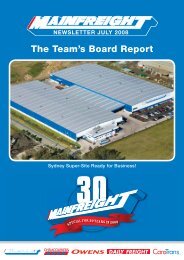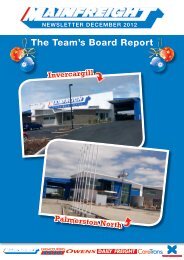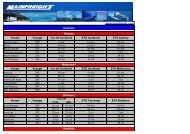Annual Report 2013 - Mainfreight
Annual Report 2013 - Mainfreight
Annual Report 2013 - Mainfreight
You also want an ePaper? Increase the reach of your titles
YUMPU automatically turns print PDFs into web optimized ePapers that Google loves.
2 Summary of Significant Accounting Policies (continued)<br />
(p) Provisions and Employee Benefits<br />
Provisions are recognised when the Group has a present obligation (legal or constructive) as a result of a past event, it is probable that<br />
an outflow of resources embodying economic benefits will be required to settle the obligation and a reliable estimate can be made of<br />
the amount of the obligation.<br />
When the Group expects some or all of a provision to be reimbursed, for example under an insurance contract, the reimbursement is<br />
recognised as a separate asset but only when the reimbursement is virtually certain. The expense relating to any provision is presented<br />
in the income statement net of any reimbursement.<br />
Provisions are measured at the present value of management’s best estimate of the expenditure required to settle the present obligation<br />
at the balance sheet date. If the effect of the time value of money is material, provisions are discounted using a current pre-tax rate that<br />
reflects the time value of money and the risks specific to the liability. The increase in the provision resulting from the passage of time<br />
is recognised in finance costs.<br />
Employee Leave Benefits<br />
(i)<br />
Wages, Salaries, <strong>Annual</strong> Leave and Sick Leave<br />
Liabilities for wages and salaries, including non-monetary benefits, annual leave and accumulating sick leave expected to be<br />
settled within 12 months of the reporting date are recognised in respect of employees’ services up to the reporting date. They<br />
are measured at the amounts expected to be paid when the liabilities are settled. Liabilities for non-accumulating sick leave are<br />
recognised when the leave is taken and are measured at the rates paid or payable.<br />
(ii) Long Service Leave<br />
The liability for long service leave is recognised and measured as the present value of expected future payments to be made<br />
in respect of services provided by employees up to the reporting date using the projected unit credit method. Consideration is<br />
given to expected future wage and salary levels, experience of employee departures, and periods of service. Expected future<br />
payments are discounted using market yields at the reporting date on national government bonds with terms to maturity and<br />
currencies that match, as closely as possible, the estimated future cash outflows.<br />
(q) Share-based Payment Transactions<br />
Equity Settled Transactions<br />
The Group provides benefits to some of its team members in the form of share-based payments, whereby team members render<br />
services in exchange for shares or rights over shares (equity-settled transactions).<br />
There is currently one type of plan in place to provide these benefits, being The <strong>Mainfreight</strong> Limited Partly Paid Share Scheme, which<br />
provides benefits to the Managing Director and senior executives.<br />
The cost of these equity-settled transactions with team members is measured by reference to the fair value of the equity instruments<br />
at the date at which they are granted. The fair value is determined by an external valuer using the Black Scholes and binomial models.<br />
Further details are given in note 25.<br />
In valuing equity-settled transactions, no account is taken of any vesting conditions, other than conditions linked to the price of the<br />
shares of <strong>Mainfreight</strong> Limited.<br />
The cost of equity-settled transactions is recognised, together with a corresponding increase in equity, over the period in which the<br />
performance and/or service conditions are fulfilled (the vesting period), ending on the date on which the relevant employees become<br />
fully entitled to the award (the vesting date).<br />
At each subsequent reporting date until vesting, the cumulative charge to the income statement is the product of; (i) the grant date<br />
fair value of the award; (ii) the current best estimate of the number of awards that will vest, taking into account such factors as the<br />
likelihood of employee turnover during the vesting period and the likelihood of non-market performance conditions being met; and (iii)<br />
the expired portion of the vesting period.<br />
The charge to the income statement for the period is the cumulative amount as calculated above less the amounts already charged in<br />
previous periods. There is a corresponding credit to equity.<br />
Equity-settled awards granted by <strong>Mainfreight</strong> Limited to team members of subsidiaries are recognised in the Parent’s separate financial<br />
statements as an additional investment in the subsidiary with a corresponding credit to equity. These amounts are eliminated on<br />
consolidation. As a result, the expense recognised by <strong>Mainfreight</strong> Limited in relation to equity-settled awards only represents the<br />
expense associated with grants to employees of the parent. The expense recognised by the Group is the total expense associated with<br />
all such awards.<br />
80 <strong>Mainfreight</strong> | <strong>Annual</strong> <strong>Report</strong> <strong>2013</strong>
















